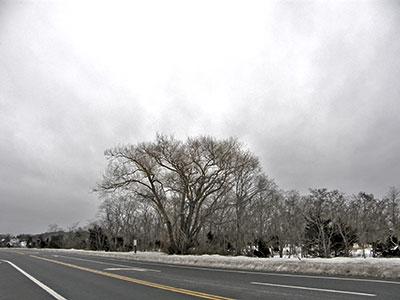Nature Notes: Pain Relief in February

While out scanning the frozen waters of Noyac Bay and Upper Sag Harbor Cove on Monday, I noticed that one of my favorite trees and the largest tree alongside Long Beach Road, a willow, was already yellowing up, anticipating spring and flowering time, which comes early for the willow clan.
Willows in the genus Salix are in the Salicaceae family along with aspens and poplars, named such by botanists because their bark is rich in salicylic acid, setting them apart from almost all of the other trees and shrubs in the world. (Salicylic acid is vital to all animals that carry on respiration because it is part of the Krebs cycle, which produces the adenosine triphosphate, or ATP, that energizes muscles for locomotion and other movements.)
Early civilizations such as the ancient Greeks were well aware of the medicinal properties of willow bark and it was widely used to relieve headaches, inflammations, and other illnesses. Primitive peoples throughout the Northern Hemisphere also knew of its powers. After Canada’s northeast and New England were settled by Europeans during the 1600s, willow species from Eurasia, such as white willow, were imported for medicinal use along with other aliens such as osier and crack willows, which were used in basketry and caning. Willows readily transplant. Just stick a willow twig in wet soil and in a few years you have a willow sapling, in 10 years, a willow tree.
In the late 1800s salicylates were isolated from willow barks by drug companies such as Bayer and combined with acetic acid to make aspirins. The “aspir” comes from the same root for “aspen,” as in quaking aspen, in the genus Populus. Until aspirins began to roll off the assembly line in bottles that were distributed globally as pain relievers, those in the Southern Hemisphere had to use other plants as anodynes because almost all of the 400 or so species of willows and poplars were situated in the Northern Hemisphere, in the higher latitudes of North America and Eurasia.
Although willows are widely imported throughout the world, their natural populations still reflect that northern distributional beginning. For example, “The Flora of Nova Scotia” by A.E. Roland and E.C. Smith lists 19 willow species, two of which are exotics, while the “Guide to the Vascular Plants of Florida” by Richard Wunderlin lists six, five of which are native. A few willow species are shrubs and one boreal species, Salix uva-ursi, the bearberry willow, doesn’t grow much higher than 21/2 inches. It’s one of the few woody plants that is found on the tundra, which is dominated by mosses and other lower plants.
One of the foreign willows that is most widely planted in America because of its unique ornamental form is the weeping willow, Salix babylonica, which actually originated in China, not from the Near East as the scientific name implies. The four native willows with the widest distribution in the United States are the peachleaf, shining, black, and Bebb’s willows. The last is the most common willow in Montauk. The famous “pussy willow,” Salix discolor, called such because of its fuzzy, plumose early spring blooms, is also fairly widespread on Long Island.
Most willows have roots that seek out water and thus have been used to stem erosion of riverbanks. By the same token, willow roots can disable septic systems and clog water mains if given the opportunity. They get going early in the spring and are active throughout most of the year. Their roots seek out the water table, and if the water in that shallow aquifer contains nutrients such as nitrates and phosphates, the roots scarf them up as well as any man-made denitrification system on the market. It’s the nitrogenous chemicals in groundwater and runoff that often find their way to water bodies and foul them up with excessive weedy vegetation and blue-green algae.
Primitive people in the Northern Hemisphere used to get their drinking water from springs and rivulets, where willows were abundant. They were not only quenching their thirst but were probably being relieved of stress and pains simultaneously because of the salicylates dissolved in that water derived from willows.
The smallest flowering plants in the world, members of the duckweed family, Lemnaceae, which are generally two-leaved and less than a quarter of an inch wide, cover the surface of some of these willow-lined vernal ponds. They accumulate the salicylates in their minute tissues, which helps in regulating flowering and the production of torulas, starchy BB-size balls, which sink to the bottom as the water turns cold in the fall and give rise to new floating duckweed plants in the spring as the water warms up.
If you are backpacking in a remote area and you come down with a crushing headache or you sprain your back and you realize suddenly that you don’t have any Aleve, Excedrin, or Bayer aspirin, try peeling some bark from the nearest willow and sucking on it, or steep it in boiling water to make a pain-relieving tea. Ethnobotanists and herbalists maintain that it still works wonders in such desperate situations, as it has for more than 2,000 years.
Before I beheld the yellowing of the great Long Beach willow against the backdrop of snow and ice on Monday, I was cold and suffering from a case of the winter blues. All of a sudden I perked up and began thinking of spring. Just looking at a yellowing willow in the dark of winter without sucking or chewing on its bark can relieve pain and work miracles.
Larry Penny can be reached via email at [email protected].
